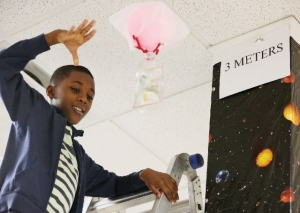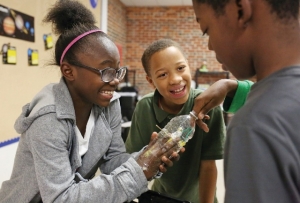Designing safe landings
By Joey Pitchford
Published in News on December 20, 2016 9:57 AM

News-Argus/CASEY MOZINGO
Bryce McCall, 10, drops his team's space shuttle from three meters during a NASA project at Kinetic Minds Monday night. Their design featured Playdough seats with rubber band seat belts and a balloon parachute. The group designed and built their own space ship for LEGO astronauts and tested its safety by dropping it.

News-Argus/CASEY MOZINGO
Kayla Bass, 11, and Tywuan Bennett, 11, laugh as Josiah Jacobs tries to get a rubber band out of the plastic bottle that they are turning into a spaceship as part of a NASA project at Kinetic Minds Monday.
Experts have estimated that the first people to walk on Mars will come from the children of today.
To reach that point, it is going to take inspiration, energy and a willingness to make mistakes. For the kids at the Kinetic Minds community learning center at 126 S. James St., those things are lessons well learned.
The center is currently part of a NASA-led Science, Technology, Engineering and Math challenge program, asking fifth-, sixth- and seventh-grade participants to design, build and test a mock crew exploration vehicle which would be used on the surface of another planet.
Working in groups, the kids used regular household items such as water bottles, plastic wrap and rubber bands to build mock vehicles which they hoped would keep the LEGO astronauts inside safe during 1-, 2- and 3-meter drops.
Kinetic Minds Executive Director Eskabonna Henderson said that he and his staff worked to get the kids in the right mindset for scientific exploration.
"We told them they were junior engineers, because that's really what they are," he said. "They're solving problems and finding solutions."
On Monday night, the children got together for step five of the eight-step process, in which they physically built their prototypes in preparation for the drops.
Materials for the build had to fit within a $4 budget, and the CEV's had to include a hatch which could open, but would remain closed during the drop. In addition, the astronauts inside could not be glued or taped down, but still had to remain stationary during their drops.
Destiny Bryant, 12, Mary Williams, 12, and Bryce McCall, 10, made up Team Two. They finished their first prototype in time to move on to stage six -- the drop test.
Using putty for the seats along with rubber band seat belts, the team fixed their astronauts inside the water-bottle CEV, which they then topped with a balloon and plastic parachute. Reaching up to the 1-meter mark, Bryce dropped the prototype, which hit the ground with a satisfying thud.
Nothing broken or displaced, the astronauts remained in their seats. A successful launch.
The 2- and 3-meter drops offered similar results. Even so, Bryce said that changes to the design would need to be made.
"We need to make it more stable, because the fuel came loose," he said. "If it was a real drop, I don't think they would have survived because there would had been a leak."
Kinetic Minds is one of only 10 community learning centers chosen to be part of the project. The center works with local schools to give children a place to learn about science and math, as well as get help with homework access to resources and materials to help further their academic success.
Anyone interested in enrolling their child at Kinetic Minds can visit their office to fill out an enrollment application.
